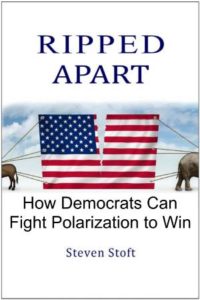So convenient a thing is it to be a rational creature, since it enables us to find or make a reason for everything one has a mind to do.
—Benjamin Franklin
“Why are you so optimistic?” I ask my radical friends. Of course, they deny it. As Bernie Sanders tells us, they believe these are the worst of times. They understand Alexandria Ocasio-Cortez (AOC) when she says her “entire generation came of age and never saw American prosperity,” and we are all pessimistic about climate change, Donald Trump and the extreme polarization of the country.
So of course, they are right to say they’re ever so pessimistic. But does that mean they’re not optimistic? Quite the contrary. Most of the radical left believes Sanders’ revolution started three years ago and is proceeding at lightning speed by historical standards. Brand New Congress was going to completely revolutionize Congress in two years. AOC says that “change is a lot closer than we think,” and she has spelled out that change in her Green New Deal, or “green dream” as Nancy Pelosi more aptly calls it. All three of these changes are billed as more fabulous than any political change the U.S. has ever seen.
This strange combination of extreme present-day pessimism and even more extreme future optimism, joined by a tipping point when we suddenly turn the corner, is nothing new. In fact, it’s a pre-biblical “ism” that has been tried hundreds of times, sometimes with astounding results. I will describe this shortly and then show how this ism organizes most of the radical-left mythology.
To be clear about the level of optimism, examine the Green New Deal, which will “secure for all people of the United States for generations to come” a guarantee that every economic need will be met and every injustice and harm to the environment will be eliminated. Of course, this will only be done to the maximum level that is technically possible—sparing no expense. And all of this will be accomplished in the space of only 10 years. Here’s a taste of what radicals guarantee you could look forward to in 10 years:
- 100-percent renewable electricity.
- All buildings upgraded to max-tech safety and durability.
- Massive growth in manufacturing.
- Max-tech removal of all pollution.
- Threatened or fragile ecosystems restored and protected.
- High-quality education and higher education for all.
- A job with a family-sustaining wage and retirement security.
- Freedom from unfair competition for every businessperson.
- High-quality health care and affordable housing.
- Economic security, affordable food and access to nature.
Of course, all programs will be developed through inclusive collaboration with vulnerable communities, labor unions, worker cooperatives, civil society groups, academia, and business. And that’s not all …
It will be a struggle to win Congress and the Presidency, and it will cost a lot, but the economy will boom immediately with great new jobs. And in only 10 years we’ll reach the promised land, where we can live in peace and harmony “for generations to come.” That last phrase, written into House Resolution 109 and signed by 67 Democrats, is a key indicator of millennialism.
Millennialism Defined
No, millennialism is not the ideology of the millennial generation. And no, it’s not about end-of-world catastrophes in the year 1000 or 2000. It’s an ism named after what may be the most powerful and disturbing Bible story, recently retold in Left Behind, a series of 16 best-selling religious novels, seven of which made it to #1 on The New York Times bestseller list. Yes, millions of people on the right still believe in Christian millennialism. The end of this epic story gave this ism its name:
An angel … laid hold on the dragon, that old serpent, which is the Devil, and Satan, and bound him a thousand years.
—Book of Revelations
“Mille” is Latin for a thousand, and “millennial” denotes a thousand years. So millennialism is an ideology that strives to catapult us into a time when the devil will be bound for 1000 years, and we can all live in peace and harmony—a sort of biblical Green New Deal.
But isn’t this just a Christian story that has nothing to do with progressive politics? Actually, you would be amazed by how many times and places this ism has taken hold. Of course, non-Christian versions usually don’t claim that the good times will last for exactly 1,000 years, but as long as they last for a very long time, it’s still called millennialism.
To convince you that millennialism is a powerful human tendency, let me tell you about a few of the hundreds of known examples. It started at least 3000 years ago, perhaps with Zoroaster, aka Zarathustra, a Persian religious leader who taught that there would be 1,000-year epochs ending in catastrophe until a great king fixes everything for all future generations.
[image]
Eugène Delacroix—Liberty Leading the People, 1830
There were many millennial movements during the Middle Ages and Renaissance. For example, Müntzer, an Anabaptist leader, taught that if the common people were to place group interests above those of the individual, they would be able to transform society (sounds rather socialistic, no?). He led 8,000 peasants into what he may have thought was the final battle between good and evil. The result was that they were massacred on May 15, 1525.
Hong Xiuquan, the self-proclaimed brother of Jesus Christ, led a rebellion from 1850 to 1864 against the Qing dynasty to establish the Taiping Heavenly Kingdom. This resulted in 20 to 70 million deaths.
The French Revolution formally began on May 5, 1789, and as a delegate to the Estates-General (a national congress) wrote: “The lower classes of the people are convinced that … we will see a total and absolute change … in conditions and income.” The French New Deal? The Bastille fell in July, and in August the National Assembly abolished feudalism and de-established the Catholic church. This was a secular millennial movement, and it was on a roll.
French people everywhere stood up and replaced the collapsing feudal establishment by building new organizations from the bottom up. According to millennialist scholar Richard Landes, “In this magical moment of forgiveness and reconciliation, vast assemblies met throughout the land, holding festivals and enacting a kind of social contract until the climax with the great commemorative festival of July 14, 1790.”
Then things began to get complicated. By 1793, Robespierre the Incorruptible felt compelled to impose the Reign of Terror, which then guillotined him on July 28, 1794. Roughly 300,000 lives were lost in the extremely brutal war to put down the counterrevolution. Nonetheless, the revolution ended in failure.
There have, of course, been many more examples. Russia’s socialist revolution had millennial characteristics, and Nazism had even more. Germany was to be “the champion of the Final Empire,” and the Third Reich was to be the Tausendjähriges Reich—the Thousand-Year Reich—or you might call it the Millennial Reich.
The Dynamic of Millennialism
Millennialism is a fundamentally irrational group dynamic that takes many paths. If I have understood Richard Landes correctly, the relevant dynamic for today’s radical-left politics is transformative, apocalyptic millennialism. “Transformative” because the millennium will come due to a change of heart, not by a violent revolution. “Apocalyptic” because the change is presumed to occur through an imminent quick struggle and not in the distant future—“closer than we think,” as AOC says.
Bernie Sanders, AOC, and Elizabeth Warren are all charismatic leaders announcing this type of millennial message. As with all millennialisms, their message says that change will come about through a struggle between good and evil—in this case, the 99% against the 1%.
This type of millennialism typically evolves through three stages if it ever takes off:
- A charismatic leader promotes apocalyptic thinking.
- An intense struggle is followed by disillusionment.
- The movement loses power and the old way returns.
We should pay the most attention to the first stage because the rise of a charismatic leader can lead to dynamic forces of group thinking (aka groupthink) which are so strong that little can be done to change course.
The first stage is powered by a sense of catastrophe. Things have (or seem to have) gone from bad to worse and, although everyone is trying individually to escape this trend, most are failing. This opens the door for a charismatic leader to propose an apocalyptic solution—one that will work quickly. To become powerfully viral, the solution should:
- Promise more than seems possible (to induce awe and excitement).
- Be untested (so there is no obvious counterevidence).
- Require that almost everyone participates (to induce intense peer pressure).
The more extreme the present catastrophe, the more extreme the solution can be. If reality is not catastrophic, the charismatic leader must make it seem that it is. This is why we find Sanders claiming (see Chapter 24) that not even counting climate change or Trump, these are the worst times since the Great Depression. And this is why AOC claims she has never seen prosperity (even though no generation has been richer).
The Basic Radical-Left Myth
The basic myth of the radical left is not one of the myths discussed in Part 4: Mythology Traps. Instead, it’s the simpler “Our Revolution” myth discussed in Chapter 16. That’s the notion that “pretty soon” the 99%—both Democrats and Republicans—will realize they’re all on the same side against the 1%, and they’ll stage a political revolution. The “People’s Party” will sweep Congress and the presidency in 2020. That’s Robert Reich’s millennialist dream.
Interestingly, this view is just a tamer version of the conclusion to Marx’s Communist Manifesto (1848): “Workers have nothing to lose but their chains. They have a world to win. Workers of the World unite!” And there you have it. The charismatic leader, Karl Marx, tells his potential followers that their situation is catastrophic—they are slaves in chains. Then he tells them (following bullet-point #1) that they can rule the world—that’s the Marxist version of the 1000-year Millennium. Then, using bullet-point #2 above, he gives them the untried solution—unite (for a revolution). And as Lenin said, the revolution requires “the sympathy and support of the overwhelming majority of the working people”—bullet-point #3.
The basic radical-left myth is straight-up apocalyptic millennialism. The mythical part of Marx’s millennialism is, as always, the notion that his solution—a socialist revolution—would bring workers to the promised land. Instead, it took them to Russian, China, North Korea, Cambodia, and most recently, Venezuela.
The Five Supporting Myths
Because the basic myth keeps failing, as millennial myths always do (after 170 years, there is still nothing remotely close to a Marxist worker paradise), it has needed updates to keep it going. Some of these are the neo-Marxist theories discussed in Part 5, but the supporting myths of Part 4 are the bread and butter of today’s radical left. Here’s how they support the basic myth of a political revolution leading to the promised land “for generations to come.”
The Democratic Socialism myth (Ch. 23) addresses the main problem of sustaining socialist millennialism—170 years of failing to reach the political revolution, the apocalypse that will overthrow the capitalist elite. Sanders deals with this dismal history by obliterating it from popular consciousness. Although he’s squarely in the socialist lane with Karl Marx, Eugene V. Debs, Norman Thomas, and Michael Harrington, he never mentions them. Instead, he pretends the socialist lane consists of Teddy Roosevelt, Franklin Roosevelt, and Lyndon Johnson.
So it looks like there have been three near-misses, but we keep getting closer. The one Sanders emphasizes is FDR’s 1944 Second Bill of Rights speech. Unfortunately, FDR died months later. Bernie’s ad claims: “Some say it can’t be done again. But another native son of New York is ready: Bernie.” (Ch. 25) The apocalypse has been delayed, but the time is almost here. That’s typical millennialism.
The Myth of the Utopian Savior (Ch. 24), holds that we have had several such saviors whose failure is due only to bad luck or nefarious plots. This myth is needed because most of us tend to doubt the existence of saviors.
The myth claims that such saviors really do exist, and we must be careful not to miss the next opportunity. These “saviors,” all of whom are grossly misrepresented by the radicals, include Teddy Roosevelt in 1912, Henry Wallace in 1944 (Ch. 12), George McGovern in 1972 and even, according to Oliver Stone, JFK, who he claims had an epiphany just before he was assassinated. But if we just elect Sanders, he’ll bring us the revolution we’ve been waiting for.
The Establishment Myth (Ch. 25) is needed because the Democrats’ heroes, the two President Roosevelts and LBJ, were each establishment figures (gold-plated one-percenters). But that contradicts the millennial myth that the 1% is entirely evil. Millennialism pits good against evil.
The Bully Pulpit myth (Ch. 26) supposedly explains how it’s possible for the charismatic leader to usher in the millennium once elected to the presidential bully pulpit.
The Overton Window myth (Ch. 27) provides followers with an easy way to participate. Giving them a role (even though it doesn’t work), especially a conspicuous role, cements their commitment to the cause. As noted, in normal times their extremist rhetoric is likely to backfire. But if and when the apocalyptic dynamic gains legitimacy, extremist positions may well add to the growing hysteria.
In conclusion, from the Communist Manifesto to the present, the radical-left strategy has focused on launching an apocalyptic millennial movement. In America, this has never taken off, but recent developments could change that. Climate change and Donald Trump both add significant real dangers. Disguising their millennial aspirations as FDR’s liberalism provides much-needed cover for the radicals while also damaging their chief competitors—real FDR liberals.
The danger is not that the radical left will lead us over the cliff into authoritarian socialism, as Republicans like to imagine. The danger comes from the very nature of millennial movements. To succeed, they must completely dominate the political views of their base. There is no room for give-and-take with Green New Deal millennialism. It’s an ideology that says perfection is technically possible so any compromise must be condemned as immoral. Here’s how AOC put it at the South by Southwest festival:
The New York Times said, and I quote, “The Green New Deal is technologically possible. Its political prospects are another question.” That, to me, is the biggest condemnation of where we’re at … our biggest obstacle is political!
AOC doesn’t see herself as political. She is simply right. This polarizes the Democratic Party. There is no room for disagreement. You either accept her religion, or you are an infidel. Of course, this weakens the party. It also polarizes the country with the message that if we do win, we will impose on Trump’s base every single point of our agenda in its purest form.
Just as they have done in the past, the radical left is weakening the liberal side and inadvertently strengthening the most reactionary forces on the right.
Myths Behind Postmodern Identity Politics
Identity politics does not fit the pattern of millennialism so closely. It focuses more on the evils of the past and present, and simply implies that when these are eradicated, we will arrive at the promised land. It differs from socialist millennialism, which diagnoses the present evil as income and wealth inequality caused by capitalism. Instead, identity politics blames European culture, particularly the Enlightenment, which it sees as White male culture.
We should expect the myths needed to support the implied millennialism of identity politics to focus on how terrible the present is and who is to blame rather than on a utopian future. This is enough, given the tacit assumption that once the evil forces are defeated, all will be right with the world.
The central microaggression myth is one of the myths supporting the idea that the evils of colonialism and slavery have continued nearly unabated. That myth holds that microaggressions “may be more harmful to people of color than hate crimes,” and that “microaggressions hold their power because they are invisible.”
But a more elaborate myth, the Space Traders Myth, will better serve to illustrate how the mythology in postmodern identity politics focuses on identifying the forces of evil.
Critical Race Theory. Derrick Bell was a prodigious civil-rights lawyer who supervised more than 300 school desegregation cases, including the famous fight that got James Meredith admitted to the University of Mississippi. But in 1992, he told The New York Times that he believed his career in civil rights was misdirected and that Blacks were worse off and more subjugated in 1992 than at any time since slavery!
By 1995, he was saying that “the concept of rights is disutile [useless].” In other words, the idea of “civil rights” was useless nonsense.
Back around 1980, Bell had been sucked in by postmodernism and “critical legal theory” and had gone on to become the most prominent founder of critical race theory. Postmodernism taught him to indoctrinate people with myths. “People … will often suspend their beliefs, listen to the story, and then compare their views, not with mine,” he said, “but with those expressed in the story.” This method of deceit ultimately comes from the corrupting influence of the elite European godfathers of postmodernism (see page before Ch. 35). Notice that Bell employed this method mainly to deceive Black students.
Here’s his favorite story, one he made up and told over and over for years. A Google search for “Derrick Bell” and “space traders” yields more than 11,500 results. He used this story in teaching his students critical race theory.
The Space Traders. “Aliens from outer space visit America on New Year’s Day in the year 2000. They promise wealth in the form of gold, environmental-cleansing material and a substitute for fossil fuels. If accepted, their gold and space-age technology will guarantee another century of prosperity for the nation. In return, the space traders want to take back to their home star all Black people. Given two weeks to decide, Americans debate the offer and vote to accept it by 70% to 30%.
“The last Martin Luther King holiday that the nation would ever observe dawned on an extraordinary sight. In the night, the Space Traders had drawn their strange ships right up to the beaches and discharged their cargoes of gold, minerals, and machinery, leaving vast empty holds. Crowded on the beaches were some 20 million silent Black men, women and children, including babes in arms. As the sun rose, the Space Traders directed them, first, to strip off all but a single undergarment; then, to line up; and finally, to enter those holds which yawned in the morning light like Milton’s ‘darkness visible.’
“The inductees looked fearfully behind them. But on the dunes above the beaches, guns at the ready, stood U.S. guards. There was no escape, no alternative. Heads bowed, arms now linked by slender chains, Black people left the New World as their forebears had arrived.”
Interpreting Space Traders. Bell is making the point that almost all Whites (they were then about 70% of the population) are just like the slave traders who sold Africans into American slavery (before some Whites outlawed the slave trade in 1808). To Whites, this slander is a baseless microaggression that it is of no consequence because we know it’s ridiculous.
But for some Blacks, this story perpetuates a harmful myth—that all American Whites were guilty of the slave trade, and most Whites alive today would sell Blacks into slavery again today if given the chance. The myth is intended to be a source of paranoia and hostility. This does Blacks far more harm than it does to Whites. But sustaining racism harms both races and is the strongest force polarizing the country.
What makes the story stick is its emotional charge rather than reason or facts. Of course, using reason and facts would go against postmodernism, which rejection of logic.
Logic and facts would also be especially inconvenient in this case because nearly all of the Africans sold into American slavery (something like 90%) were sold by Black Africans, not Whites. Moreover, “Africans were selling African slaves to the Islamic world centuries before the Atlantic slave trade. And the Islamic slave trade lasted somewhat longer, in some places into the twentieth century” (from a review published in The American Historical Review of seven books on African slavery).
My point is not, in any way, to excuse any aspect of American slavery. Rather, my point is that condemning whole races is the problem, not the solution, and Critical Race Theory (aka identity politics) is contributing to that problem, which, as we know, hurts Blacks far more than Whites. Derrick Bell was well-intentioned and once did enormous good, but he was later captured by elite European postmodern “philosophy” and became a strong force for racial and political polarization.
Conclusion
Democratic socialism, the Green New Deal and even Elizabeth Warren’s catalog of miraculous plans are all descriptions of different utopian dreams. Each is accompanied by the promise that we can, if we reject normal Democratic politics, capture the federal government in one or two elections and launch a utopia.
Identity politics holds out a more implicit promise: People of Color can quickly defeat White supremacy and take over the government. No plans or utopian vision is needed, but all will be well after that changing of the guard.
The myths of the first group are classic millennialism, and the last myth is close enough. All will fail, as all millennial movements do. None of that would matter if the hyper-optimistic dreamers were tolerant of those who did not share their optimism. Instead, they harshly judge any who do not swear allegiance to their changing dogmas.
But those of us in the pragmatic, FDR-liberalism camp must not let ourselves be silenced and must take heart in knowing that our past political heroes were, every one of them, relentlessly down to earth. And in 2018, the pragmatic depolarizers won big. We can do it again if we can tame or bypass the well-intentioned, outrage-prone radicals in our own party.

 Ripped Apart
Ripped Apart

